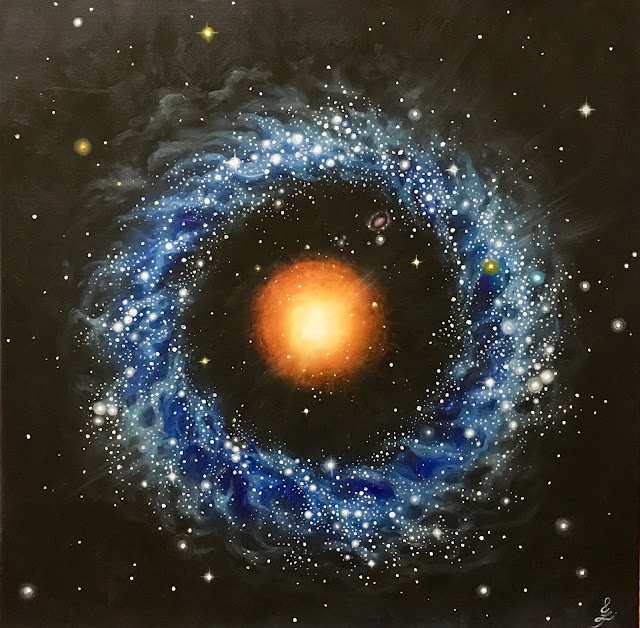Fiat lux: This is how light was made in the universe after 180 million years of darkness.
Through the detection of a radio signal from the early universe, the first indication of the formation of stars and the end of the so-called Dark Age of the cosmos can be had, a look at the cosmic history of a period of the ancestors of the stars and galaxies.
It should be clear that the Big Bang theory is a theory with some gaps and spaces that new cosmological theories try to fill, as is the case with the inflationary theory, since the Big Bang theory does not explain what caused the origin of the universe and details the first millionths of a second of Planck's time of the evolutionary processes that led to the appearance of the first particles and so on, but there is a tiny space where it is still a mystery and physics stops working, between that infinitely dense singularity and the Beginning of Planck's time, it is that tiny space where the four unified forces that later separated should live. It goes without saying that the Big Bang was not an explosion but an expansion of the same space on itself and that it was not totally dark, but had a faint glow due to the intense radiation and it was not silent, in that expanding space. the expansion of the singularity caused a sound of 180 decibels. Everything in fractions of a thousand billionths of billionths of millionths of millionths of a second until we reach the physics that is understood about how matter behaves, between that beginning of time and Planck's time lies the mystery still unsolved and its understanding would lead to a new physics beyond Relativity itself..
This whole process was carried out in a space the size of a proton until cosmic inflation caused the universe to expand the size of an orange to twice what it was in a process much faster than light. These events occurred 13.8 billion years ago according to cosmological theories, and after a few seconds before the first minute the universe was an immense and homogeneous space, but still very strange, there is a long way to go for the formation of the first stars and galaxies. The echo of that expansion was recorded in a cosmic microwave background that permeates everything, but when only 380,000 to 400,000 years had passed, darkness came, at least within the length visible to the human eye, if you could go to that moment nothing would be seen, just pure darkness, but the light is there, at a very low wavelength. The universe in its beginnings was illuminated by intense radiation due to the high temperatures of the formation of the first atomic nuclei, but when the temperature began to drop below 2,500 million degrees, that light began to diminish more and more until it became a colder space but with agglomerations of uneven matter increasingly dense, bumps created by cosmic inflation to wrinkle space – time during the accelerated expansion of the universe, which caused a difference in density in those regions that caused the accumulation of more matter, later giving rise to stars and galaxies.

For almost 200 million years, the known germs of the universe were feeding in the shadow of the dark mantle of space-time, in that darkness nothing more than many processes of changes and transformations happened, an abyss with activity that nobody could seeing the light was forbidden to penetrate these secrets. The matter was grouping assisted by the gravitational power of dark matter and, finally, the conditions began to give rise to the first stars that were incredibly massive and illuminated the entire universe with their intense brightness due to the enormous amount of matter. That they accreted, being stars much more immense than those already known today. These huge, blue, short-lived stars ignited and died spectacularly like hypernovae and ending up as black holes, they began to emit ultraviolet radiation that changed the cosmic ecosystem. The radiation modified the energetic state of the hydrogen atoms that became independent from the cosmic background radiation and dawn began in the Universe.
At the moment of losing neutrality, the hydrogen began to emit or absorb the surrounding radiation at a specific wavelength: 21 centimeters, the equivalent of a frequency of 1,420 megahertz. With the expansion of the universe and following the norm of the redshift, by which the wavelength of radiation increases with distance, the radio signals reaching the Earth are around 100 megahertz.
In order to find this signal as evidence of the first stars after the Dark Age of the Universe, the emission range of that original hydrogen was calculated, assuming that it would be hotter than its surroundings. Then the model was changed to conform to a colder gas and the search frequency was lowered, until the radio wave signal that was intended to be found in a range of 78 megahertz was found.
Found the original hydrogen gave way to a new question, what had motivated the hydrogen to cool? One of the possibilities would be that the radiation temperature of the universe at that time was higher than that of the cosmic microwave background based on measurements from the ESO Herschell Telescope. The second option suggests that interactions with dark matter, much colder than conventional, would explain the mismatch between theories and what was observed. If the latter is correct, dark matter takes the cosmos out of 200 million years of darkness.
_________
By: Alejandro Sebastián von Heguer, National University of Lomas de Zamora, Buenos Aires. Genesis of the Cosmos.
Source: Judd Bowman, University of Arizona, United States / Rennan Barkana, Massachusetts Institute of Technology (MIT)










Comentarios
Publicar un comentario